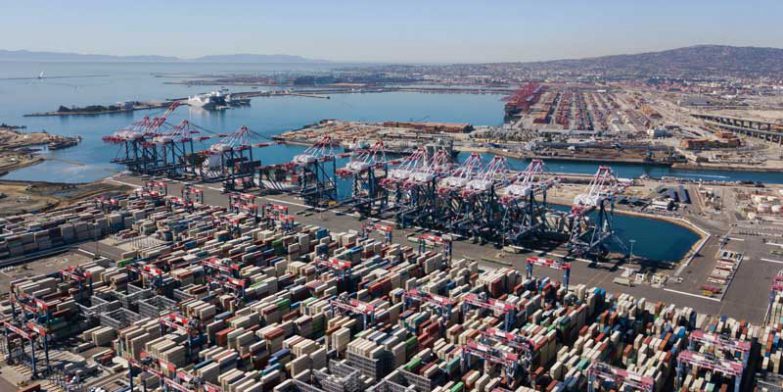
The latest Drewry World Container Index is now 85% below its 2021 peak and 42% lower than the 10-year average, indicating a return to more normal prices. However, it remains 10% higher than average 2019 (pre-pandemic) rates.
OCEAN
Overcapacity in the sea freight market is forcing some carriers to idle new ultra large vessels before their maiden voyages from Asia to Europe, as the market remains soft, though prices remain slightly above 2019 levels.
On the transpacific, capacity is scheduled to increase as much as 25% to the US West Coast and 35% to the East Coast in the coming months as carriers take delivery of new vessels.
To prevent freight rates from collapsing, Sea-Intelligence predict that carriers will reduce effective capacity through a “massive number of blank sailings, which will drag down vessel on-time performance.
Carriers have already been announcing additional blanked sailings to Europe in the weeks after the Golden Week holiday, suggesting that demand is expected to decrease in the weeks that would typically be in the peak season from Asia.
The percentage of industry-wide blanked capacity between Asia and Europe in week 34 of the year, increased from an average of 6.8% in previous years to a significant 19.9% in 2023.
During Golden Week, percentage capacity reductions increased from a typical 11.1% to 17.0%, while in the three weeks following Golden Week, we are seeing an increase to 13.8%.
Transpacific rates to the West Coast have come down slightly, about 7%, so far this month, while prices to the East Coast have remained relatively static.
Though ocean volumes remain relatively strong on the Asia to Mediterranean trade, rates continue to soften and the current level is the lowest for this lane since 2019, probably due to carriers adding too much capacity when demand proved resilient, and now carriers are trying to remove capacity to match volumes.
AIR
August, for the air freight market was very quiet, as was July, and there are no meaningful signals of any kind of peak arising this year, which suggests that any demand recovery is unlikely this year.
While the market seems to have levelled out, there is still a lot of uncertainty and with multiple blank sailings scheduled around the Golden Week period, with passenger belly-hold capacity also likely to be withdrawn, there could be upward pressure on air freight rates in the second half of October.
Demand growth simply does not exist currently, or for the foreseeable future and volume shippers will be tempted to try and fix longer-term deals because the levelling of volumes and imminent drop-off of belly-hold capacity means the market may not get any better than it is right now.
Data shows that spot rates declined 37% year on year and that of the 10 major trade lanes assessed in the past month, only China-US and Southeast Asia-US recorded growth, with air cargo spot rates up 3% and 4% respectively on these corridors. This is attributed to a more resilient US economy with strong retail sales and, to some extent, also delayed recovery of US-China passenger belly-hold capacity, which is growing at a much slower pace than Europe-China.
Capacity shortages triggered by geopolitical issues, mean that Air freight spot rates ex Northeast Asia to Middle East & Central Asia, Northeast Asia to Europe, China to the US and China to Europe remained highly elevated, still up by around 55% from their pre-pandemic levels.
ROAD
The deteriorating economic climate is having a downward impact on road freight transport prices in Europe. In the second quarter of 2023, the Ti/Upply/IRU road freight rates index lost ground, for the second consecutive quarter on the contract market and for the third consecutive quarter on the spot market.
Nevertheless, it is important to note that road freight prices in Europe remain on average 12-15% higher than before the pandemic, reflecting a structural increase in hauliers’ costs.
According to latest IRU driver shortage data, the shortage of truck drivers in Q2 2023 was slightly lower than a year ago, with 7% of truck driver positions remaining unfilled versus 9.7% at the end of 2021 and while some driver shortages are easing, the shortage is still applying upward pressure on rates.
The outlook for the coming months is for further reduction in demand side pressure freeing up capacity and allowing for the possibility of further rate falls in the spot market.
The European transport market moved at a lower level in the first half of 2023 as compared to the previous year and is underperforming figures posted in the pre-Corona year 2019.
After the last two atypical years, which remained affected by the pandemic and its recovery effects, road transport as a whole has quietened down significantly.
In Q2 2023 there were 46.3% fewer freight offers on average in the spot market across Europe, as compared to Q2 2022.
Whatever challenges your supply chain may face, our commercial vehicle fleet and the price and capacity agreements we have in place with our long-term partner air and ocean carriers mean that we continue to deliver resilient and reliable supply chain solutions.
Our purchase order management and supply chain tracking technology support the most demanding global trading regimes, providing transparency and control.
EMAIL Andy Costara to learn more and see how our technology can support your supply chain.





